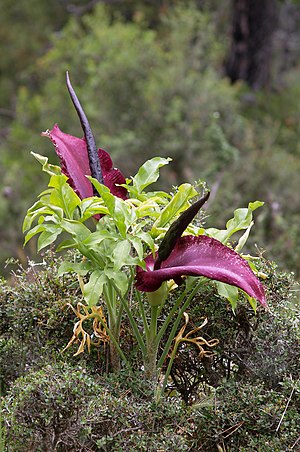Dracunculus vulgaris
Ζῶμεν γὰρ οὐχ ὡς θέλομεν, ἀλλ' ὡς δυνάμεθα → Ut quimus, haud ut volumus, aevum ducimus → nicht wie wir wollen, sondern können, leben wir
Wikipedia EN
Dracunculus vulgaris is a species of aroid flowering plant in the genus Dracunculus and the arum family Araceae. Common names include the common dracunculus, dragon lily, dragon arum, black arum and vampire lily. In Greece, part of its native range, the plant is called drakondia, the long spadix being viewed as a small dragon hiding in the spathe.
This herbaceous perennial is endemic to the Balkans, extending as far as Greece, Crete, and the Aegean Islands, and also to the south-western parts of Anatolia.
Latin > Greek
ἀγχομανές, ἄμι ἄγριον, ἄρον, ἀρωνία, ἀσκληπιάς, αὔγειον, ἄφρισσα, δορκάδιον, δρακόντιον
Translations
Dracunculus vulgaris
Arabic: لُوف الحَيّة, لُوف الجَعْد, لُوف جَعْدِيّ, لُوف أَرْقَط, لُوف كَبِير, صَرَّاخَة, فِيلْجُوش, طُرْقُنْطِيَة / طَرْقِنْطِيَة, خُبْز الْغُرَاب, دْرَاقُنْطِيُون, قُلُبْرِيَالَّة; Catalan: dragoneta, colobra, dragontina, dragontea, serpentària; Finnish: kreikanlohikäärmevehka; French: gouet, serpentine / serpentaine / serpentaire, coulevrée; German: Drachenwurz; Greek: δρακοντιά; Ancient Greek: ἀγχομανές, ἄμι ἄγριον, ἄρον, ἀρωνία, ἀσκληπιάς, αὔγειον, ἄφρισσα, δορκάδιον, δρακόντιον; Latin: dracunculus, colubrina, serpentina / serpentinaria, viperina, dracontea; Latin: Dracunculus vulgaris; Ottoman Turkish: ییلان یاصدغی; Persian: فیل گوش; Serbo-Croatian: zmijinac, zmijavčica and zmijavičica; Spanish: dragontea, zumillo, dragoneta; Turkish: yılan yastığı

